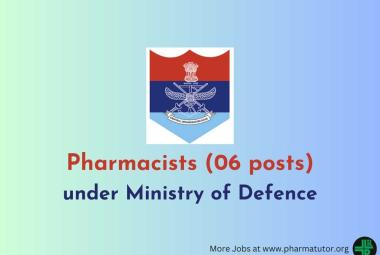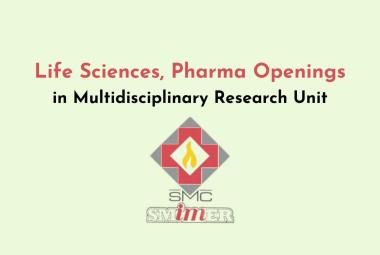About Author: Kale Vishal Bibhishan
Department Of Pharmacy, School Of Chemical Engineering and Bio-Technology
SASTRA UNIVERSITY, Thanjavur-613402, Tamil Nadu, INDIA
Reference ID: PHARMATUTOR-ART-1064
Abstract
Pre-clinical phase is a laboratory test of a new drug on animal subjects, conducted together evidence justifying a clinical trial. For those drugs which are in clinical phase, method development requires various pre-clinical bioanalytical support parameters. Bioanalytical support plays a pivotal role in answering a series of questions concerning the toxicity, pharmacokinetic parameters, safety assessment, formulation optimization .Once method development process was initiated one should know the different techniques of sampling, handling, sample preparation methods that are suitable and problems in it. After sample preparation, suitable analytical techniques have to be selected for method development. The developed method now have to be validated, for this, Initially “Analytical Instrument Qualification” has to be performed which includes four main phases- Design qualification, Installation qualification, Operational qualification and Performance qualification. Method is said to be validated when all considered validation parameters like linearity, specificity, selectivity etc are within the limits. Thus the method is developed and validated for a drug in preclinical phase using analytical technique of suitable sensitivity and selectivity.
[adsense:336x280:8701650588]
Introduction
Pre clinical development represents critical stages in the progression from discovery to marketed pharmaceuticals drug candidates.Timely bioanalytical support is essential to improve the success rate of drug candidate. Preclinical phase(1) – A laboratory test of a new drug or a new invasive medical device on animal subjects; conducted to gather evidence justifying a clinical trial.Bioanalytical support of preclinical development phase presents some unique challenges. A series of questions concerning the toxicity, pharmacokinetic (PK) parameters, safety assessment, formulation optimization, and so on need to be answered. Bioanalytical support plays a pivotal role in answering these questions.
Timely bioanalytical support is essential to improve the success rate of drug candidates moving along the preclinical development pipeline and allows decisions to be made early to modify/improve the drug candidates or terminate the program.
The four unique characteristics of bio analytical support are Good Laboratory Practice (GLP) requirements, Good metabolic selectivity coverage, quick time for method development, validation and sample analysis, Stream lining of the process at various stages of bio-analytical support.(2)
Regulatory requirement: FDA guidance on Bioanalytical Method Validation (BMV) provide a general guideline on parameters including methods specificity/selectivity,sensitivity,linearity,accuracy,precission,stability, matrix effects, carry over and contamination.
Batch Failure Rate: Batch failure rate has been particularly useful to assist the method ruggedness or reliability. Excluding execution errors good bioanalytical method should achieve at least 80% passing.
Metabolic Selectivity: Metabolic stability, adjusting the pH, the addition of enzymatic inhibitors are needed to stabilize the both parent compound and its metabolite.
Method Development Strategy: typically consists of three important inter related parts- Sample preparation, Chromatography, Mass Spectroscopy (MS) Detection.
Analyte Adsorption Issue: Loss of analyte during the collection of incurred samples preparation of Quality Control (QCs) storage and analysis due to adsorption to the container should be taken.
Method Automation Strategy: Automation results in greater performance consisting over time and in more reliable methods. Matrix Effects And Recovery, Effect Of Dosing Vehicle, Trouble Shooting Strategy.
Method specificity: [Refer table 2] It is based on the ability of these anti-bodies to specifically interact with the drug molecule or opposed to interact with non-drug (cross reactant) molecules. Antibody specificity is generally evaluated by determining cross reactivity of anti-body with non-drug molecules including drug metabolites and structurally related drug. To evaluate anti-body specificity dose response curves are generated.An anti-body with 20% cross activity with a potential contamination may be acceptable.
Method Selectivity: During method development atleast 10 individual samples from 10 normal animals or subjects, are assayed unspiked and spiked with the drug at a concentration near the lower end of Calibration curve (CC) [Table2].Acceptable recovery of drug in atleast 80% of the samples is considered and indicated that the method is selective. (3)
Minimal Required Dilution Of Sample: It is the dilution at which matrix interference is minimized to an acceptable level. The reported concentration of analyte is the product of the measured concentration multiplied by the dilution factor. Method with smallest value has acceptable interference and sensitivity for the intended use would be ideal. [Refer table 2]
Analyte Stability In Biological Matrix (4): Proteolytic enzyme compositions have a distinct effect on the stability of the drug in biological matrix. It has been our experience that an analyte may be stable in rabbit or monkey serum may vary well and be highly unstable in rat or mouse serum. Therefore, in such cases it may be necessary to collect the study samples in the presence of a cocktail of proteolytic enzyme inhibitors and/or keep the samples on ice during analysis. To support preclinical studies an analyte specific Ligand Binding Assay (LBA) must be validated to confirm GLP regulations.LBA has 3 phase lifecycles. [Refer table2]
Table 2: Summary of method validation assessment parameters over the method life cycle
|
Performance parameters |
development |
Pre study validation |
In study validation |
|
Critical reagents Assay format/batch size Matrix of calibrators and controls Minimal required dilution Analytes stability Specificity Selectivity Calibration curve fitting algorithm LLOQ & ULOQ Precision & accuracy Run acceptance QC(low,medium,high) Dilution linearity Batch size Robustness/ruggedness Parallelism Run acceptance criteria |
Identity and procure Establish Establish Establish Initiate Establish Evaluate Establish Evaluate Evaluate evaluate establish evaluate evaluate evaluate where possible N/A |
Apply Apply Confirm Confirm Establish Apply Confirm Confirm Establish establish establish confirm establish establish evaluate where possible runs accepted based on calibration curve acceptance criteria |
Apply Apply Apply Apply Ongoing assessment Apply Apply Apply Apply Apply Apply Apply-confirm if extended Apply-confirm if extended Monitor Establish with incurred samples. Runs accepted based on acceptable calibration curve & QC samples |
PRE-CLINICAL ANALYTICAL METHOD DEVELOPMENT
Back Ground: Analytical methodology is an essential element of drug development from the initial synthesis, manufacture through clinical trials and post marketing monitoring. In new drug applications (NDAs), abbreviated NDA (ANDAs), biologics license applications (BLAs) or product license applications (PLAs) - Data must be submitted to establish that procedures meet proper FDA is GLP and ICH guidelines of accuracy and reliability and information on method validation. For successful conduct of preclinical safety and efficacy-Selective and Sensitive Validated Analytical Methods for Quantitative Evaluation of Drug (5)
Active pharmaceutical ingredient manufacturing, control, stability, shelf-life, forecast
- Synthetic contaminants, degradation products-manufacturing, stability, shelflife forecast.
- Pharmaceutical excipients.
- Drug and metabolites in biological fluids and tissues.
Analytical Method Development
(a) Sampling & Handling(6): It is one of the most important factors in a high quality analysis. Since the three basic activities involved in solving an analytical problem.
1. Collection and handling of appropriate sample
2. Preparation of sample for analysis.
3. Analysis using an appropriate method.
Key points of Sampling
Laboratory shall have a sampling plan and procedures for sampling.
Plans shall be reasonable, be based on appropriate statistical methods.
Sampling procedure shall describe the selection, sampling plan, withdrawl and preparation of sample.
Recording relevant data and operations relating to sampling
[adsense:336x280:8701650588]
b) Sample Preparation(7): Sample preparation is very important first and often critical step in the analytical method, especially when biological samples are involved. Typically it’s the most difficult and time consuming step.
Table 3: Relative Comparison Of Commonly Used Sample Preparation Methods
|
Factor |
Direct Injection |
Filtration |
Precipitation |
LLE |
SPE |
||
|
Simplicity |
++++ |
+++++ |
+++++ |
+++ |
+++ |
||
|
Speed |
+++ |
++++ |
++++ |
+ |
+++ |
||
|
Resultant Sample Cleanliness |
++ |
+ |
+ |
+++++ |
+++++ |
||
|
Resultant Analyte Concentration |
+ |
+ |
+ |
+ |
+++ |
||
|
Selectivity |
+ |
+ |
+ |
+++ |
++++ |
||
|
Solvent Consumption |
++ |
+ |
+++ |
+++++ |
++ |
||
|
Possible Injections per Column |
++ |
++ |
++ |
+++++ |
+++++ |
||
Purpose(8): To isolate analytes of interest from interfering sample components, concentrate the analytes, and dissolve them in a suitable solvent for subsequent separation and detection.
Sample Problems:
Lack of compatibility with the chromatographic system.
Being too dirty.
Being too dilute.
Analytical Techniques For Method Development
1) NonSeparation Methods(9), (10): Absorption and emission spectroscopy, isotope assays, isotope dilution assays (IDA), neutron activation analysis (NAA)
2) Separation Methods: Chromatography - TLC, GC, HPLC, CE; Chiral methods.
Analytical Method Validation For Pre-Clinical Analysis
Installation, Operation, Performance Qualification & Maintenance Of Instrumentation
The method after successfully developed its time for the Process to be validated. For successful method validation a qualified instrument is required. Hence phases “Analytical Instrument Qualification (AIQ)” will be used instead of “Analytical Instrument Validation.”
AIQ is divided in to 4 main phases (11)
Design Qualification (DQ) for setting functional and performance specifications.
Installation Qualification (IQ) for performing documenting the installation in the selected user environment
Operational Qualification (OQ) for testing the equipment in the selected user environment to ensure that it meets the previously defined functional & performance specifications.
Performance Qualification (PQ) for testing that the system consistently performs as intended for the selected application.
Validation Parameters (13):
1) Specificity: It is the ability to assess unequivocally the analyte in the presence of components that may be expected to be present. [Refer table6]
2) Accuracy &Precision: Represents an agreement between measured and theoretical values .5 samples per concentration should be used to validate. Mean valve should be within 15% of the theoretical value coefficient of variation 15%. [Refer table6]
3) Limit Of Detection (LOD) : Lowest amount of analytes that can be detected but not accurate/precise. Commonly 3:1 should be signal to noise ratio or 3 times the standard deviation of the response divided by slope of the calibration curve. [Refer table6]
4) Limit of Quantification (LOQ): lowest and highest concentrations that can be quantified with adequate accurate and precision.10:1 S/N ratio. Here 10 times the SD of response divided by slope of Calibration Curve (CC).
5) Linearity and Range: linearity refers to directly proportional between response and analytes concentration. Commonly 5 to 8 concentrations are used for standard curve. Range refers to concentration between the low & high limit of quantification.
6) Stability: Stress studies performed by exposing the analytes to acid, base, heat, UVlight to assess their stability.
7) Ruggedness: Refers to reproducibility under normal but variable conditions (different instruments, operators, labs, reagents)
8) Robustness: Refers to analytical methods ability to remain unaffected by small changes in operational parameters and in used to define acceptable tolerances.
9) Transferability and Revalidation: After method has been validated, it is ready to be transferred to other that will be using this method. Revalidation should be carried out in a reactive and proactive manner.
10) System Suitability: It is determined by checking a system to ensure system performance before and during.
Guidelines: ICH , FDA , AOAC , USP , ISO 9000, and ISO 17025
It includes following:
Q1A (R2): Stability Testing of New Drug Substances and Products (Second Revision) (14)
Q1B: Photo stability testing of New Drug Substances and Products (15)
Q1C: Stability Testing for New Dosage Forms(16)
Q1D: Bracketing and Matrixing Designs for Stability Testing of Drug Substances and Drug Products (17)
Q1E: Evaluation of Stability Data ( 8)
Q1F: Stability Data Package for Registration Applications in Climatic Zones III and IV. (19)
Q2A: Text on Validation of Analytical Procedures
Q2B: Validation of Analytical Procedures —Methodology
Q3A(R): Impurities in New Drug Substances (Revised Guideline)
Q3B(R): Impurities in New Drug Products (Revised Guideline)
Q3C: Impurities —Guideline for Residual Solvents. (20)
Q9: Quality Risk Management. (21)
Table 6 - ICH Validation Characteristics
|
Procedure Product specification |
ID test Present/ absent |
Quantitative Limit test ≤20% |
Qualitative Limit test ≤5% |
Content Purity ≥80% |
Content range 40-60% |
|
Accuracy |
No |
Yes |
No |
Yes |
Yes |
|
Repeatability |
No |
Yes |
No |
Yes |
Yes |
|
Specificity |
Yes |
Yes |
Yes |
Yes |
Yes |
|
Linearity |
No |
Yes |
No |
Yes |
Yes |
|
Range |
No |
Yes |
No |
Yes |
Yes |
|
LOD |
No |
no |
Yes |
No |
No |
|
LOQ |
no |
Yes |
No |
no |
No |
Good Laboratory Practice(GLP)
Analytical lab should follow. GLPs for all preclinical drug development.GLP requirements for analytical laboratories include:
Established and standard SOPs.
Use of labeled, traceable reagents.
Maintenance of several requirements.
Having calibrated and maintained equipment.
Attention of five steps of data acquisition for product analysis can help to focus on the goals of compliance activities
Planning - Performing - Monitoring - Recording - Reporting
Method Validation Protocol
A validation plan is a written plan stating how validation will be conducted, including test parameters, product characteristics, production equipment, and decision points on what constitutes acceptable results.
Assumptions:
• Selectivity has been measured and documented during the validation protocol.
• The method has been developed and optimized with robustness being the first parameter investigated.
• Statistically valid approaches to evaluate and make decisions for removing the subjectivity of method validation.
The following stepwise protocol can be proposed for method validation
Linearity test - Repeatability test - Intermediate precision - LLOQ - LLOD
Conclusion
Analytical technology leads to improvements in sensitivity and selectivity. Selection of tools based on nature of analytes, analytical goals (sensitivity, selectivity etc), sample matrix and sample stability. Tools should not be used blindly but analyst understands of theory, techniques, instrumentation and inherent limitations. Analytical methods need to be subject to appropriate method validation, including periodic instrument testing and calibration and should incorporate appropriate quality control measures. In addition, stability of analytes needs to be considered from time of sample collection through final analytical measurement.
Table 1: Bioanalytical support for discovery, pre-clinical and clinical studies
|
|
discovery |
Pre clinical |
clinical |
|
Regulatory requirement
LC-MS/MS method
Validation
Validation strategy
Sample analysis
Sample analysis strat |
Non-GLP
Generic
Minimal
Abbreviated method validation, minimal stability test.
Small sets of samples per compound but hundreds or thousands of compounds. Streamline process from sample collection to data generation. Use of generic methods also allows easier setup for automation. |
GLP
Tuned to compound requires extensive method development
Extensive validation to multiple matrices in multiple species
Full validation for one species and partial validation for other species including incurred sample reproducibility has large curve range that may be problematic due to carry over or ionization saturat’n. Moderate numbers of samples for dozens of compounds.
Due to relatively small sets of samples and various methods tuned for each compound, automation is feasible but may not be feasible for some methods due to limited sample volumes. |
Although GLPs only apply to pre clinical studies, clinical falls under the guidance and by practice the same standards as the GLPs. Tuned to compound requires extensive method development but could leverage preclinical methods. Extensive validation but limited to human samples. Specificity tests to co-administered compounds.
Full validation including incurred sample analysis very sensitive method may be needed for high potency candidate.
Large numbers of samples for very few compounds.
Quick turnaround time for sample analysis (automated sample preparation, multiplexing, HPLC) to allow data to be released. |
Table 4: Relative Comparison Of Most Commonly Used Separation Methods
| PARAMETERS | TLC | GLC | HPLC | CE |
| Resolution | + | ++++ | +++ | ++++ |
| Clean Sample Requirement | + | ++++ | ++ | ++ |
| Potential Sensitivity | + | ++++ | ++++ | +++ |
| Need for derivatization | + | ++++ | + | + |
| Different separation mode options | + | +++ | ++++ | ++++ |
| Available sensitive/selective detectors | + | ++++ | ++++ | ++++ |
| Automation | + | ++++ | ++++ | +++ |
| System cost | + | ++++ | ++++ | +++ |
Table 5: Software-Analytical Works
| Firm Ware | Data Acquisition &Processing Software |
Stand Alone Soft Ware |
| Computerized instrument with low level software chips | For controlling of operation of installation. | Guide for validating. |
References:
1. Lee MS, Kerns ED. LC/MS applications in drug development. Mass Spectrum Review, 1999; 18: 187 – 279.
2. Gu H, Unger S, Deng Y, et al. Automated Tecan programming for bioanalytical sample preparation With EZTecan. Assay Drug Dev Technol, 2006; 4: 721 – 733
3. Brewer E, Henion J. Atmospheric pressure ionization LC/MS/MS techniques for drug Disposition studies. J Pharm Sci, 1998; 87: 395 – 402.
4. Jemal M, Xia Y-Q. LC-MS development strategies for quantitative bioanalysis. Cur Drug Metab, 2006; 7: 491- 502.
5. Kyranos JN, Cai H, Wei D, Goetzinger WK, et al.High-throughput high-performance liquid chromatography/mass spectrometry for modern drug discovery. Curr Opin Biotechnology, 2001; 12: 105 – 111.
6. Shah VP, Midha KK, Dighe SV, et al. Analytical method Validation Assessment. J Pharm Sci, 1992; 81: 309 – 312.
7. Taylor PJ. Matrix effects: the Achilles heel of quantitative high - performance liquid chromatography - electro spray - tandem mass spectrometry-Analytical Method Validation. Clin Biochem, 2005; 38 (4): 328 – 334.
8. Vas G, Vekey K. Solid - phase micro extraction: a powerful sample preparation tool prior to mass spectrometric analysis. J Mass Spectrum, 2004; 39 (3): 233 – 254.
9. Ohkura Y, Kai M, Nohta H, et al. Fluorogenic reactions for biomedical chromatography. J Chromatogr B Biomed Appl, 1994; 659(1–2): 85–107.
10. Halket JM, Zaikin VV. Derivatization in mass spectrometry. Eur J Mass Spectrum (Chichester), 2004; 10 (1): 1 – 19.
11. Bansal SK, Layoff T, and Bush ED. Qualification of analytical instruments for use in the pharmaceutical industry: a scientific approach.AAPS PharmSciTech, 2004; 5(1): 22-25.
12. Huber L.Validation and Qualification in Analytical Laboratories. Boca Raton, 1999; 4: 23-78.
13. Shah VP, Midha KK, Findlay JW, et al. Bioanalytical method validation — a revisit with a decade of progress. Pharm Res, 2000; 17 (12): 1551 – 1557.
14. ICH Q1A (R2): Stability Testing of New Drug Substances and Products (Second Revision). Fed Reg, 2003; 68(225):2844-2945.
15. ICH Q1B: Photo stability Testing of New Drug Substances and Products. Fed Reg, 1997; 62(95): 27115 – 27122.
16. ICHQ1C: StabilityTesting for New Dosage Forms. Fed Reg, 1997; 62(90): 25634–25635.
17. ICH Q1D: Bracketing and Matrixing Designs for Stability Testing of Drug Substances and Drug Products. Fed Reg, 2003; 68(11): 2339 – 2340.
18. ICH Q1E: Evaluation of Stability Data. Fed Reg, 2004; 69(110): 32010 – 32011.
19. ICH Q1F: Stability Data Package for Registration Applications in Climatic Zones III and IV. Fed Reg, 2003; 68(225): 65717 – 65718.
20. ICH Q3C: Impurities: Guideline for Residual Solvents. Fed Reg, 1997; 62(247): 67377-67379.
21. Q9: Quality Risk Management. Fed Reg, 2005; 70(151): 45722 – 45723.









